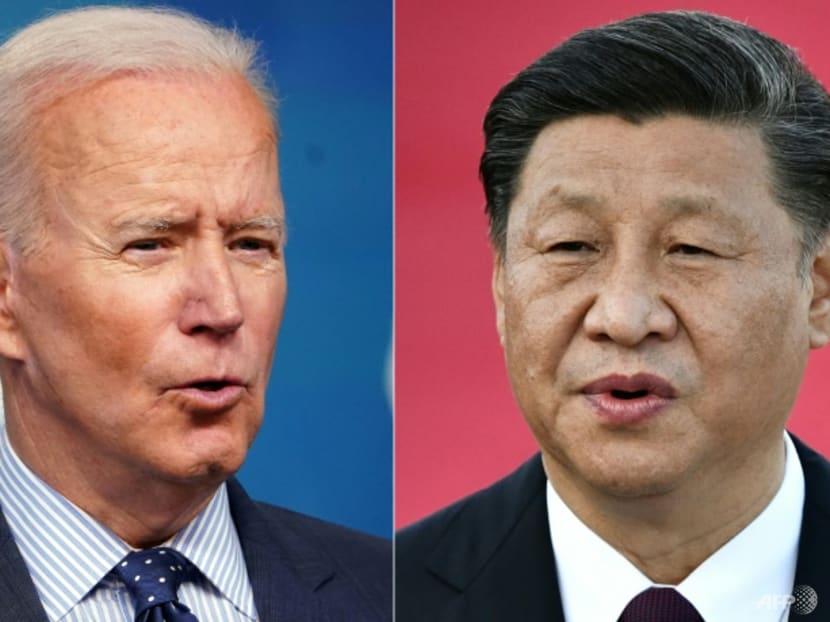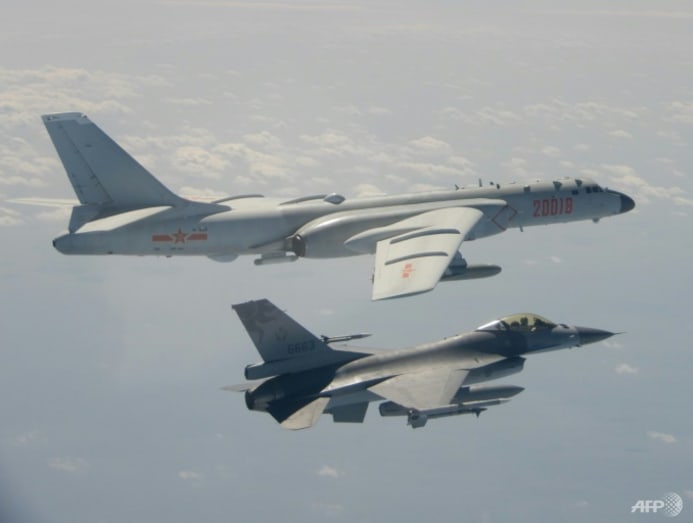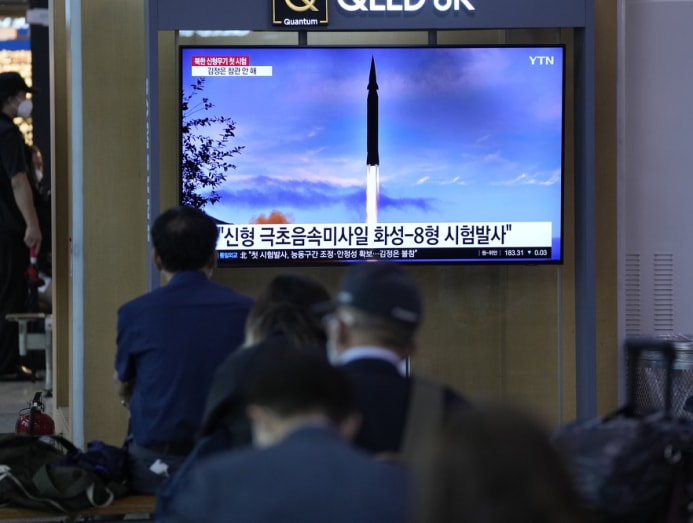Commentary: Real potential for US, China to 'sleepwalk' into great power conflict
Advertising
Commentary
Commentary: Existent potential for US, China to 'sleepwalk' into peachy power conflict
High-level US-China talks are welcome developments, only many more than steps are needed to erect the scaffolding for responsible competition, says a researcher.

12 Oct 2022 06:04AM (Updated: 29 Dec 2022 04:50PM)
WASHINGTON DC: The annunciation that Presidents Joe Biden and Eleven Jinping will meet in a virtual summit before the cease of the year take raised prospects that Washington and Beijing can brainstorm to set up "guardrails" to prevent Usa-Prc contest from tipping into outright conflict.
Despite Biden'southward accent in his speech at the United nations General Associates that the Usa is "not seeking a new Cold War or a world divided into rigid blocs" and Xi's argument that disputes should "exist handled through dialogue and cooperation", the intensifying rivalry between the 2 states has been very much in the spotlight.
The current trajectory of Us-China relations and trendlines in the Indo-Pacific are apropos, and wise leadership on the part of Washington, Beijing and the middle powers of the region volition be essential to prevent a migrate toward zero-sum disharmonize.
Since coming into office, the Biden administration has proposed that the United States will simultaneously face up and compete with China, while seeking cooperation in areas of mutual interest.
Beijing, nonetheless, has rejected this framework, making the example that Washington should not expect China's cooperation on issues like climate change as long as it continues to challenge People's republic of china's policies elsewhere.
Chinese leaders have expressed that the "ball is in the United states court" to rectify its "misguided policies". This past July, Beijing presented U.s.a. Deputy Secretarial assistant of State Wendy Sherman with "three bottom lines and 2 lists".
Included in these are demands that the US must refrain from criticising China'south domestic system and its policies toward Hong Kong, Xinjiang, Tibet and Taiwan, and that all sanctions, tariffs and export restrictions imposed on China exist removed.

This counterproposal harkens back to President Xi's calls for a "new type of major ability relations", which was kickoff proposed to the Obama administration in 2022 and urged the two sides commit to "no conflict and no confrontation, mutual respect, and win-win cooperation".
Yet NO MODUS OPERANDI FOR United states-People's republic of china RELATIONS
At the time, the Obama administration resisted this framework for several reasons, including concerns that Beijing would interpret U.s.a. endorsement of the concept equally blanket credence of China'southward cadre interests.
Today, there is nil chance that such a proposition would exist accustomed in Washington given heightened threat perceptions of Mainland china among policymakers and the general public.
Negative perceptions of Cathay take not just spiked in the United States, but throughout the Indo-Pacific and beyond.
Beijing's "wolf warrior affairs", coupled with its rapid military machine expansion, aggressive positions in the Due east and South China Seas, and its use of economical coercion accept pushed several states, namely Australia, Japan and India. Just a few years ago these sought to maintain practiced ties with both China and the United States, but now lean decisively toward the latter.
In fact, Beijing's heavy-handed behaviour in the Indo-Pacific has served every bit a principal strength for the growing contour of the Quad and the creation of the AUKUS security pact, both of which China has condemned as United states-led containment schemes that threaten peace in the region.
It's unclear how much cocky-reflection, if any, is happening in Beijing. While at that place must be sober diplomats and policy experts who realise China's wolf warrior approach has backfired in many cases, there is likely piddling, if whatever, space for such views to be expressed.
This is due to the popularity of the Chinese Communist Party'southward nationalistic appeals that it will not tolerate "strange bullying", and the deep resentment amid Chinese leaders and the full general public of the increasingly hardline policies adopted past the U.s. and its allies toward China.
THE Ascension OF COMPETING COALITIONS
While China'southward precipitous criticism of the Quad and AUKUS is expected, a number of Indo-Pacific states accept also expressed anxiety most the growth of multilateral pacts that at their core seemed to exist aimed at countering Cathay.
Some, like Southward Korea, have been conscientious to avert explicitly embracing these groupings.
The Asean (Association of southeast asian nations) states have communicated concerns about the rise of other multilateral mechanisms overshadowing their own. Malaysia and Republic of indonesia, in particular, accept voiced concerns about AUKUS triggering an arms race and exacerbating the security dilemma in the region.
Recognising this feet and the demand to have a positive vision that extends beyond countering China, the US and its fellow Quad members accept developed a remarkably comprehensive agenda for the group.
It places a heavy emphasis on providing public goods to the region and includes efforts on COVID-xix vaccines, regional infrastructure needs, and combatting climate change.
Communist china, too, has sought to cooperate with ASEAN states on many of these same areas. And in a neighbourhood where vaccines are in brusk supply and significant investments in infrastructure are needed to tackle poverty and climate alter, a boost in attending and resources could be a boon for the region.
Despite this silver lining to the competitive dynamics in the region, the growing chasm between Cathay and the The states and its closest partners has also made it harder to tackle challenges for which coordination and joint activity are indispensable.

Withal Beijing's protests about the potential nuclear proliferation risks posed past AUKUS, a nuclear arms race is already underway in the region.
North Korea is continuing to build its nuclear and missile programme, and China is rapidly expanding its own nuclear arsenal and strategic capabilities with an eye on great power competition with the U.s.a..
A workable roadmap for the denuclearisation of North korea or the adoption of artillery control measures to reduce the risks of nuclear state of war are only possible with Washington and Beijing working together.
Thus, while growing involvement and engagement in the Indo-Pacific may bring some benefits to the region, more public appurtenances will non atomic number 82 to a more than prosperous region if the toughest security challenges are left to the wayside.
PREVENTING Migrate TOWARD ZERO-SUM Competition
Looking at recent trendlines, at that place is real potential for the United States and China to drift into a fraught, zero-sum relationship. When both sides come across less value in preserving their relationship, space for diplomacy to manage bilateral and global challenges will naturally diminish as well.
While in that location'south no silver bullet to reverse this trend, it will take leadership and action on the function of all parties in the region to ensure that the world does not sleepwalk into a great ability conflict.
This week's meeting between US National Security Advisor Jake Sullivan and China's tiptop diplomat, Yang Jiechi, was described equally "more meaningful and substantive" than previous engagements.
News of the Biden-Xi summit, and US Trade Representative Katherine Tai'south reference to "durable coexistence" while outlining the Biden administration's approach to the US-Red china trade relationship are all encouraging developments.
Simply many more steps will exist needed to erect the scaffolding for responsible competition.
Outset, Beijing must cease demanding a render to some mythical past of US-China relations when all was harmonious. America and Red china accept never seen to center-to-eye on all issues, but in past decades attempted to work constructively together in some areas, while maintaining sharp differences in others.
Beijing should not characterise cooperation on shared challenges every bit "favours" to Washington or potential vehicles for tradeoffs in other areas. It should smooth the mode for its bureaucrats to substantively engage with their American counterparts for its ain benefit.
Washington should continue to seek a multifaceted human relationship with China – engaging in healthy competition with Beijing and against its unfair or coercive behaviour when necessary; pursuing good faith negotiations where the ii sides have a mix of alien and converging interests, like merchandise and artillery control; and persistently pursuing cooperation to accost common challenges.
Striking a residue amid the "3 c's" volition be difficult only critical. And wise leadership will be necessary to ensure that beingness tough on China does not go an end, but ane of multiple ways to foster a genuinely free, open up, inclusive and prosperous Indo-Pacific.
Setting up guardrails to compete and coexist peacefully in years ahead will take swell efforts by diplomats on both sides.
This will require non just establishing a broad working framework for the relationship, but also getting into the weeds to identify issue areas and domains where the lack of rules and norms are exacerbating the risks of escalation and finding ways to address these gaps.

In addition, existing risk reduction and crisis management mechanisms, such as codes of conduct and hotlines, should be examined for effectiveness and improved upon.
Finally, middle powers can play an essential role by continuing to telephone call attention to regional needs and spearheading multilateral initiatives to accelerate peace in their neighbourhood.
While Beijing and Washington may be reluctant to accept proposals coming from the other's uppercase given the current land of relations, they may be more receptive to cooperative initiatives from third parties.
Center powers should seek to capitalise on their distinct equities and interests, such as managing maritime disputes for littoral states or seeking peace on the Korean Peninsula for Seoul, to rally the necessary stakeholders for articulation action and move trendlines in a more positive direction.
Patricia 1000 Kim is a David M Rubenstein Fellow at Brookings, and holds a joint appointment to the John Fifty Thornton China Center and the Center for Eastward Asia Policy Studies in Washington, DC. This commentary first appeared on Brookings' blog, Order From Chaos.
Contempo Searches
Trending Topics
Source: https://cnalifestyle.channelnewsasia.com/commentary/us-china-biden-xi-summit-sullivan-yang-trade-talks-relations-aukus-security-nuclear-295716

0 Response to "Commentary: Real potential for US, China to 'sleepwalk' into great power conflict"
Postar um comentário